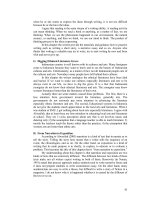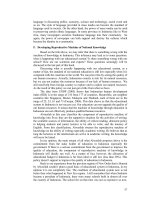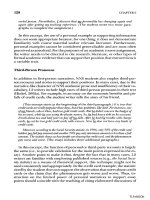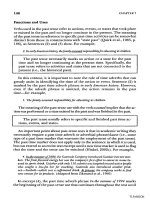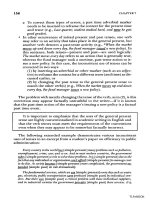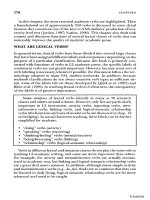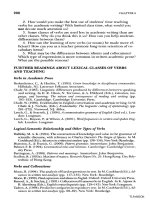Tài liệu Teaching and learning english part 11 doc
Bạn đang xem bản rút gọn của tài liệu. Xem và tải ngay bản đầy đủ của tài liệu tại đây (409.45 KB, 7 trang )
71
stations. Such stations are called VORTACs. Because TACANs include distance
measuring equipment, VOR/DME and VORTAC stations are identical in
navigation potential to civil aircraft.
5. Radar
Radar (RAdio Detection And Ranging) detects things at a distance by
bouncing radio waves off them. The delay caused by the echo measures the
distance. The direction of the beam determines the direction of the reflection.
The polarization and frequency of the return can sense the type of surface.
Navigational radars scan a wide area two to four times per minute. They use
very short waves that reflect from earth and stone. They are common on
commercial ships and long-distance commercial aircraft.
General purpose radars generally use navigational radar frequencies, but
modulate and polarize the pulse so the receiver can determine the type of surface
of the reflector. The best general-purpose radars distinguish the rain of heavy
storms, as well as land and vehicles. Some can superimpose sonar data and map
data from GPS
position.
Search radars scan a wide area with pulses of short radio waves. They
usually scan the area two to four times a minute. Sometimes search radars use
the doppler effect
to separate moving vehicles from clutter. Targeting radars use
the same principle as search radar but scan a much smaller area far more often,
usually several times a second or more. Weather radars resemble search radars,
but use radio waves with circular polarization and a wavelength to reflect from
water droplets. Some weather radar use the doppler
to measure wind speeds.
6. Emergency services
Emergency Position-Indicating Radio Beacons (EPIRBs), Emergency
Locating Transmitters (ELTs) or Personal Locator Beacons (PLBs) are small
radio transmitters that satellites can use to locate a person or vehicle needing
rescue. Their purpose is to help rescue people in the first day, when survival is
most likely. There are several types, with widely-varying performance.
7. Data (digital radio)
Most new radio systems are digital, see also:Digital TV, Satellite Radio,
Digital Audio
Broadcasting. The oldest form of digital broadcast was spark gap
telegraphy
, used by pioneers such as Marconi. By pressing the key, the operator
could
send messages in Morse code by energizing a rotating commutating spark
gap. The rotating commutator produced a tone in the receiver, where a simple
spark gap would produce a hiss, indistinguishable from static. Spark gap
transmitters are now illegal, because their transmissions span several hundred
megahertz. This is very wasteful of both radio frequencies and power.
The next advance was continuous wave telegraphy
, or CW (Continuous
Wave), in which a pure radio frequency, produced by a vacuum tube electronic
oscillator was switched on and off by a key. A receiver with a local oscillator
would "heterodyne
" with the pure radio frequency, creating a whistle-like audio
tone. CW uses less than 100 Hz of bandwidth. CW is still used, these days
primarily by amateur radio
operators (hams). Strictly, on-off keying of a carrier
should be known as "Interrupted Continuous Wave" or ICW.
Radio teletypes
usually operate on short-wave (HF) and are much loved
by the military because they create written information without a skilled
operator. They send a bit as one of two tones. Groups of five or seven bits
72
become a character printed by a teletype. From about 1925 to 1975, radio
teletype was how most commercial messages were sent to less developed
countries. These are still used by the military and weather services.
Aircraft use a 1200 Baud radioteletype service over VHF to send their
ID, altitude and position, and get gate and connecting-flight data. Microwave
dishes on satellites, telephone exchanges and TV stations usually use quadrature
amplitude modulation (QAM). QAM sends data by changing both the phase and
the amplitude of the radio signal. Engineers like QAM because it packs the most
bits into a radio signal. Usually the bits are sent in "frames" that repeat. A
special bit pattern is used to locate the beginning of a frame.
Systems that need reliability, or that share their frequency with other
services, may use "corrected orthogonal frequency-division multiplexing" or
COFDM
. COFDM breaks a digital signal into as many as several hundred
slower subchannels. The digital signal is often sent as QAM on the subchannels.
Modern COFDM systems use a small computer to make and decode the signal
with digital signal processing
, which is more flexible and far less expensive than
older systems that implemented separate electronic channels. COFDM resists
fading and ghosting because the narrow-channel QAM signals can be sent
slowly. An adaptive system, or one that sends error-correction codes can also
resist interference, because most interference can affect only a few of the QAM
channels. COFDM is used for WiFi
, some cell phones, Digital Radio Mondiale,
Eureka 147
, and many other local area network, digital TV and radio standards.
8. Heating
Radio-frequency energy generated for heating of objects is generally not
intended to radiate outside of the generating equipment, to prevent interference
with other radio signals. Microwave ovens
use intense radio waves to heat food.
(Note: It is a common misconception that the radio waves are tuned to the
resonant frequency of water molecules. The microwave frequencies used are
actually about a factor of ten below the resonant frequency.) Diathermy
equipment is used in surgery for sealing of blood vessels. Induction furnaces are
used for melting metal for casting
.
9. Mechanical force
Tractor beams can use radio waves which exert small electrostatic and
magnetic forces. These are enough to perform station-keeping in microgravity
environments.
10. Other
Amateur radio is a hobby in which enthusiasts purchase or build their
own equipment and use radio for their own enjoyment. They may also provide
an emergency and public-service radio service. This has been of great use,
saving lives in many instances. Radio amateurs are able to use frequencies in a
large number of narrow bands throughout the radio spectrum. They use all forms
of encoding, including obsolete and experimental ones. Several forms of radio
were pioneered by radio amateurs and later became commercially important,
including FM, single-sideband AM, digital packet radio and satellite repeaters.
Personal radio services such as Citizens' Band Radio
, Family Radio Service,
Multi-Use Radio Service
and others exist in North America to provide simple,
(usually) short range communication for individuals and small groups, without the
overhead of licensing. Similar services exist in other parts of the world. A number of
73
schemes have been proposed Wireless energy transfer. Various plans included
transmitting power using microwaves
, and the technique has been demonstrated.
(See Microwave power transmission
). These schemes include, for example, solar
power stations in orbit beaming energy down to terrestrial users.
Radio remote control
use sof radio waves to transmit control data to a remote
object as in some early forms of guided missile
, some early TV remotes and a range
of model boats, cars
and aeroplanes. Large industrial remote-controlled equipment
such as cranes
and switching locomotives now usually use digital radio techniques
to ensure safety and reliability. Energy autarkic radio technology
consists of a small
radio transmitter powered by environmental energy (push of a button, temperature
differences, light, vibrations, etc.).
D. Radio and Education
Educational radio has been employed within a wide variety of instructional
design contexts. In some cases it is supported by the use of printed materials, by
local discussion groups, and by regional study centres. It is sometimes designed so
as to permit and encourage listener reaction and comment. Indeed, in some cases,
there is provision for the audience to raise questions and to receive feedback. The
purpose of the present paper is to explore some of the various instructional design
formats in which educational radio has been employed. In addition the paper
reviews some of the evaluative studies and the recommended practices regarding
educational radio in developing countries which emerge from this literature. The
following list of examples, educational radio has been utilized in:
1. Thailand, to teach mathematics to school children (Galda, 1984), and for teacher
training and other curricula (Faulder, 1984).
2. India, for rural development (Long, 1984).
3. Swaziland, for public health purposes (Byram & Kidd, 1983).
4. Mali, for literacy training (Ouane, 1982).
5. Columbia, for various programs (Muhlmann de Masoner, Masoner, & Bernal,
1982).
6. Mexico, for literacy training and other programs (Ginsburg & Arias-Goding,
1984).
7. Nigeria, for management courses for the agriculture sector (Shears, 1984).
8. Kenya, in support of correspondence courses (Kinyanjui, 1973).
9. Nicaragua, for health education (Cooke & Romweder, 1977).
10. The Phillipines, for nutrition education (Cooke & Romweder, 1977).
11. Guatemala, in order to promote changes in farming practices and to improve
production (Ray, 1978).
12. Sri Lanka, for family planning and health (Academy for Educational
Development, 1980).
13. Trinidad and Tobago, to promote knowledge of breastfeeding (Gueri, Jutsen &
White, 1978).
14. South Korea, in support of family planning (Park, 1967).
15. Botswana, for civics education (Byram, Kaute & Matenge, 1980).
16. The Dominion Republic, in support of primary education (White, 1976
17. Paraguay, to offer primary school instruction (Academy for Educational
Development, 1979).
74
E. The Advantages of Radio in Education
Evaluation of communication programs, projects and experiments have
repeatedly shown that radio can teach; it can present new concepts and information
(Galda & Searle, 1980; White, 1976, 1977; Leslie, 1978; Jamison & McAnany,
1978; Byram, Kaute & Matenge, 1980; Hall & Dodds, 1977; McAnany, 1976). In
this regard, Sweeney and Parlato (1982) concluded that radio plays an effective
educational role both as the sole medium or in conjunction with print and group
support (p. 13).
For example, in a project for teaching mathematics by radio to school
children in primary grades in Nicaragua, students who were taught through radio
lessons achieved significantly higher scores in the final evaluation than those taught
through regular, face-to-face, classroom instruction. Rural students, tested against
rural control groups, benefited more than urban students tested against urban control
groups (Galda & Searle, 1980). The project evaluators hypothesized that radio
lessons were particularly effective in raising the level of knowledge of those who
knew least, which in this case were the rural students.
Using a format which combines entertainment, humor and instruction,
Kenya's nationwide weekly radio program, "Giving Birth and Caring for Your
Children," was measured effective in educating the audience about modern child
care practices (Hostetler, 1976; Jamison & McAnany, 1978). The results indicated
that more than one-half of those interviewed listened for the educational content,
while more than one-third listened for the entertainment. The survey showed general
recognition of the major theme (child care), and a high recall on topics covered by
the program.
The potential of radio to motivate listeners to take action, modify behaviour,
and undertake activities is evident in the literature reviewed thus far. In some cases,
radio has been used effectively to advise populations of new government policies
and to encourage discussion, feedback, and eventual support for new measures.
Radio has also been used to promote community development, innovation, and other
programs in which self-help and community participation are essential (Bryam,
Kaute & Matenge, 1980; Cassirer, 1977; Punasiri & Griffin, 1976). There is some
evidence to suggest that radio alone can bring about results (Ray, 1978; Cooke &
Romweber, 1977). Other reports have examined the results of radio when used in
conjuntion with some form of interpersonal support such as discussion/study groups,
printed materials or contact with extension workers (Cerqueira et al., 1979;
Bordenave, 1977), and found them to be very efficient and effective.
While most communication and education experts agree that radio can play
an important role in inducing change, the ability to bring about such change using
radio alone remains controversial. Sweeney and Parlato (1982) state that:
established theories of communication hold that human interaction is necessary at
some point in getting individuals to adopt innovations (p. 16).
It should be noted that most of the evaluation studies reporting change in behaviour
were based on self-reported action by those interviewed, rather than by independent
observation. Accordingly, the potential of radio has been particularly difficult to
ascertain on this issue. Nonetheless, there is some evidence about change and
actions produced by radio in developing countries. For example, a five-year "Basic
Village Education" project was carried out in two geographic areas of Guatemala in
1973. The purpose of the project was to change farming practices and improve
75
production through a constant flow of information (Ray, 1978). Reviewing the
evaulation, Sweeney and Parlato (1982) concluded that:
For the Spanish-speaking farm area, radio alone was an adequate source of
information, much of which was tranlsated into action. For the less developed area,
a mixture of radio and home visits by a field worker and an agricultural specialist
worked best (p. 16).
Further, the "Radio Farm Forum Pilot Project" of Thailand (Punasiri &
Griffin, 1976) concluded that the crucial element of radio forums was the
opportunity they afforded members to exchange experiences and ideas and to
participate in group problem solving. The two-way flow of information between
farmer and extension worker improved retention and overall learning of participants
because of a high interest in content of broadcasts and the opportunity for
discussion. Messages were reinforced by various communication channels such as
radio, literature, and field visits by extension agents and technicians. Agricultural
broadcasting was made relevant to farmer problems through the exchange of ideas
and problem-solving discussions.
Many writers have proposed that educational radio can be most effective
when supported by trained facilitators, group learning, group discussion (dialogues),
feedback and the use of multimedia approaches. For example, Perraton (1978)
argued that trained facilitators must be used in order to successfully utilize
educational radio. Similarly, Higgs and Mbithi (1977) contend that a "good program
has to be backed by careful training of trainers, preparation of training materials and
continuous improvements in these" (p. 42). Perraton (1978) stated that group
learning is more effective than individual learning; and that group discussion is an
effective method of learning from radio. The facilitator must converse with students
in order to emphasize the main points covered by radio programs as well as to
provide feedback where necessary. The facilitator must ensure that programs are
supported by visual demonstrations, that groups are cohesive, and that discussions
are carried out effectively by employing techniques of group discussion (Daniel &
Marquis, 1983; Moore, 1983). Also multi-media such as print materials, posters,
films and chalk boards must be used to elaborate the main points to students.
Based upon experience with the Open University, Sewart (1983) claimed the
study centres where students interact, help each other, replay programs and
opportunities for practical experiments are important. The study centre aids the
effectiveness of educational radio and acts as a link between the institution and the
local community in which it is embedded.
Neil (1981) contends that educational radio can only be effectively utilized
by employing the following techniques:
1. Using educators with long (and preferably recent) experience of living in rural
areas.
2. Communicating, in detail and continually, with the leaders of village learning
groups where these exist.
3. Paying careful attention to, and learning from, the work of local communities or
other organized groups (for example, farmers, agricultural and health service
radio broadcasters).
4. Working through valid intermediaries such as chiefs or headmen in villages, i.e.,
through established and accepted social structures.
5. Encouraging illiterate people to communicate their ideas and concerns through
trusted and better educated villagers, who can act as scribes if required.

